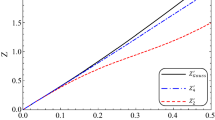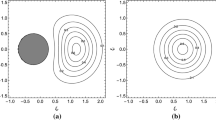Abstract
In this work, we present a quantum key distribution protocol using continuous-variable non-Gaussian states, homodyne detection and post-selection. The employed signal states are the photon added then subtracted coherent states (PASCS) in which one photon is added and subsequently one photon is subtracted from the field. We analyze the performance of our protocol, compared with a coherent state-based protocol, for two different attacks that could be carried out by the eavesdropper (Eve). We calculate the secret key rate transmission in a lossy line for a superior channel (beam-splitter) attack, and we show that we may increase the secret key generation rate by using the non-Gaussian PASCS rather than coherent states. We also consider the simultaneous quadrature measurement (intercept-resend) attack, and we show that the efficiency of Eve’s attack is substantially reduced if PASCS are used as signal states.









Similar content being viewed by others
References
Bennett, C.H., Brassard, G.: Quantum cryptography: public key distribution and coin tossing. In: Proceedings of the IEEE International Conference on Computers, Systems and Signal Processing, pp. 175 (1984)
Scarani, V., et al.: The security of practical quantum key distribution. Rev. Mod. Phys. 81, 1301 (2009)
Shor, P.W., Preskill, J.: Simple proof of security of the BB84 quantum key distribution protocol. Phys. Rev. Lett. 85, 441 (2000)
Stucki, D., et al.: High rate, long-distance quantum key distribution over 250 km of ultra low loss fibres. New J. Phys. 11, 075003 (2009)
Ralph, T.C.: Continuous variable quantum cryptography. Phys. Rev. A 61, 010303(R) (1999)
Hillery, M.: Quantum cryptography with squeezed states. Phys. Rev. A 61, 022309 (2000)
Cerf, N.J., Lévy, M., Van Assche, G.: Quantum distribution of Gaussian keys using squeezed states. Phys. Rev. A 63, 052311 (2001)
Horak, P.: The role of squeezing in quantum key distribution based on homodyne detection and post-selection. J. Mod. Opt. 51, 1249 (2004)
Grosshans, F., Grangier, P.: Continuous variable quantum cryptography using coherent states. Phys. Rev. Lett. 88, 057902 (2002)
Grosshans, F., et al.: Quantum key distribution using Gaussian-modulated coherent states. Nature 421, 238 (2003)
Vidiella-Barranco, A., Borelli, L.F.M.: Continuous variable quantum key distribution using polarized coherent states. Int. J. Mod. Phys. B 20, 1287 (2006)
Lorenz, S., Korolkova, N., Leuchs, G.: Continuous-variable quantum key distribution using polarization encoding and post selection. Appl. Phys. B 79, 273 (2004)
Namiki, R., Hirano, T.: Security of quantum cryptography using balanced homodyne detection. Phys. Rev. A 67, 022308 (2003)
Leverrier, A., Grangier, P.: Unconditional security proof of long-distance continuous-variable quantum key distribution with discrete modulation. Phys. Rev. 102, 180504 (2009)
Peev, M., et al.: The SECOQC quantum key distribution network in Vienna. New J. Phys. 11, 075001 (2009)
Sasaki, M., et al.: Field test of quantum key distribution in the Tokyo QKD Network. Opt. Express 19, 10387 (2011)
Jouguet, Paul, et al.: Experimental demonstration of long-distance continuous-variable quantum key distribution. Nat. Photon. 7, 378 (2013)
Leverrier, A. et al.: Quantum communications with Gaussian and non-Gaussian states of light. In: International Conference on Quantum Information, OSA Technical Digest (CD) (Optical Society of America, 2011), paper QMF1. http://www.opticsinfobase.org/abstract.cfm?URI=ICQI-2011-QMF1
Pariggi, V., Zavatta, A., Kim, M., Bellini, M.: Probing quantum commutation rules by addition and subtraction of single photons to/from a light field. Science 317, 1890 (2007)
Silberhorn, C., Ralph, T.C., Lütkenhaus, N., Leuchs, G.: Continuous variable quantum cryptography: beating the 3 dB loss limit. Phys. Rev. Lett. 89, 167901 (2002)
Lütkenhaus, N.: Security against eavesdropping in quantum cryptography. Phys. Rev. A 54, 97 (1996)
Dakna, M., Knöll, L., Welsch, D.-G.: Quantum state engineering using conditional measurement on a beam splitter. Eur. Phys. J. D 3, 295 (1998)
Agarwal, G.S., Tara, K.: Nonclassical properties of states generated by the excitations on a coherent state. Phys. Rev. A 43, 492 (1991)
Zavatta, A., Viciani, S., Bellini, M.: Quantum-to-classical transition with single-photon-added coherent states of light. Science 306, 660 (2004)
Wang, Z., Yuan, H., Fan, H.: Nonclassicality of the photon addition-then-subtraction coherent state and its decoherence in the photon-loss channel. J. Opt. Soc. Am. B 28, 1964 (2011)
Wigner, E.: On the quantum correction for thermodynamic equilibrium. Phys. Rev. 40, 749 (1932)
Hillery, M., et al.: Distribution functions in physics: fundamentals. Phys. Rep. 106, 121 (1984)
Wu, J.W.: Violation of Bells inequalities and two-mode quantum-optical state measurement. Phys. Rev. A 61, 022111 (2000)
Ou, Z.Y., Hong, C.K., Mandel, L.: Relation between input and output states for a beam splitter. Opt. Commun. 63, 118 (1987)
Lütkenhaus, N.: Security against individual attacks for realistic quantum key distribution. Phys. Rev. A 61, 052304 (2000)
Shannon, C.E.: A Mathematical theory of communication. Bell Syst. Tech. J. 27, 379 (1948)
Becir, A., Wahiddin, M.R.: Phase coherent states for enhancing the performance of continuous variable quantum key distribution. J. Phys. Soc. Jpn. 81, 034005 (2012)
Acknowledgments
This work was partially supported by CNPq (Conselho Nacional de Desenvolvimento Científico e Tecnológico—INCT of Quantum Information), FAPESP (Fundação de Amparo à Pesquisa do Estado de São Paulo—CePOF of Optics and Photonics) and CAPES (Coordenação de Aperfeiçoamento de Pessoal de Ensino Superior), Brazil.
Author information
Authors and Affiliations
Corresponding author
Rights and permissions
About this article
Cite this article
Borelli, L.F.M., Aguiar, L.S., Roversi, J.A. et al. Quantum key distribution using continuous-variable non-Gaussian states. Quantum Inf Process 15, 893–904 (2016). https://doi.org/10.1007/s11128-015-1193-8
Received:
Accepted:
Published:
Issue Date:
DOI: https://doi.org/10.1007/s11128-015-1193-8




